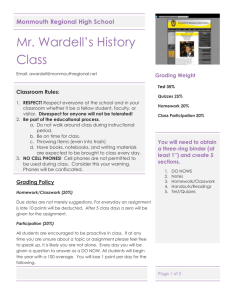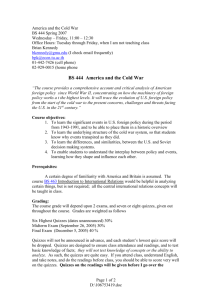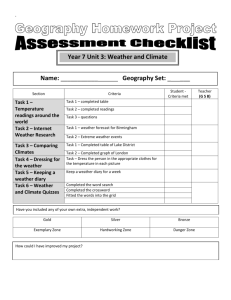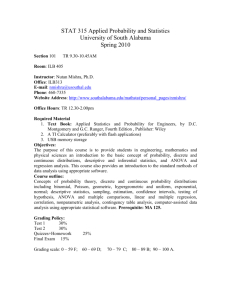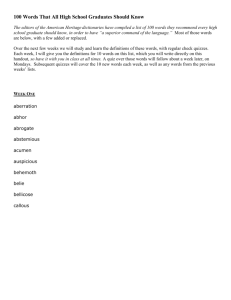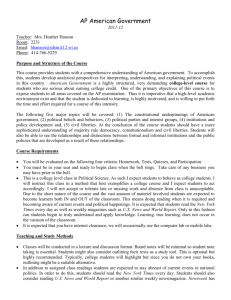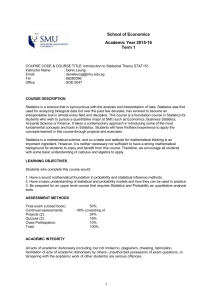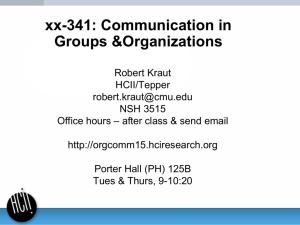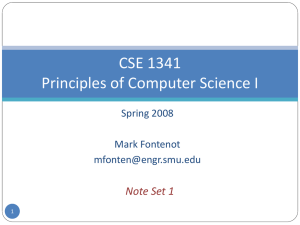Syllabus
advertisement
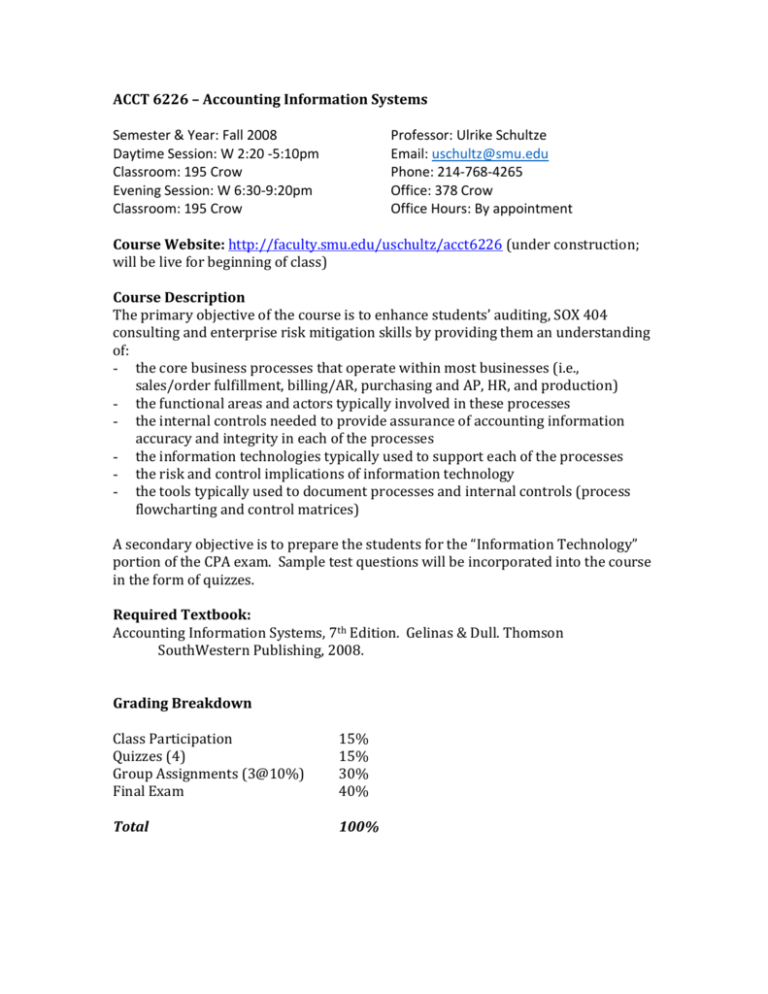
ACCT 6226 – Accounting Information Systems Semester & Year: Fall 2008 Daytime Session: W 2:20 -5:10pm Classroom: 195 Crow Evening Session: W 6:30-9:20pm Classroom: 195 Crow Professor: Ulrike Schultze Email: uschultz@smu.edu Phone: 214-768-4265 Office: 378 Crow Office Hours: By appointment Course Website: http://faculty.smu.edu/uschultz/acct6226 (under construction; will be live for beginning of class) Course Description The primary objective of the course is to enhance students’ auditing, SOX 404 consulting and enterprise risk mitigation skills by providing them an understanding of: - the core business processes that operate within most businesses (i.e., sales/order fulfillment, billing/AR, purchasing and AP, HR, and production) - the functional areas and actors typically involved in these processes - the internal controls needed to provide assurance of accounting information accuracy and integrity in each of the processes - the information technologies typically used to support each of the processes - the risk and control implications of information technology - the tools typically used to document processes and internal controls (process flowcharting and control matrices) A secondary objective is to prepare the students for the “Information Technology” portion of the CPA exam. Sample test questions will be incorporated into the course in the form of quizzes. Required Textbook: Accounting Information Systems, 7th Edition. Gelinas & Dull. Thomson SouthWestern Publishing, 2008. Grading Breakdown Class Participation Quizzes (4) Group Assignments (3@10%) Final Exam 15% 15% 30% 40% Total 100% Class Participation: Considering the interactive nature of the class sessions, class participation is an important part of the learning experience in this course. Please make every effort to attend class and to contribute to the discussion. Prepare for each class by reading the assigned material and answering the study questions. I take the following into account in grading class participation: Attendance: If you are not there, you cannot participate. In-Class Participation: The following are some guidelines that I use to grade class participation. If you almost never speak up in class or miss several classes, you will receive a participation grade of no higher than a C. If you contribute occasionally but rarely say anything inspired, your participation grade will be some sort of a B. The path to an A participation grade involves things like: integrating conceptual materials from the readings and applying them to a case or real-life situation, doing a bit of outside reading/research and applying it to the class discussion, integrating comments made by fellow-students earlier in the discussion, taking substantive issue with a class-mate’s analysis, and generally demonstrating that you have understood the readings. Quizzes With the exception of the first class session, there will be a quiz in the first 10 minutes of every class. Please be on time for class; no extra time will be given to ‘late arrivals.’ The quizzes will contain questions from past CPA exams as well as back-of-chapter questions from chapters assigned for the class session. Of the six quizzes given during the course of this module, only the top 4 will be counted towards students’ final quiz grade. Group Assignments In groups of 4-5, students will complete three process and control documentation exercises. Each assignment will require a flowchart drawn in Visio (or an equivalent flowcharting tool), a control matrix and narrative explanations of the entries in the control matrix. Professionalism with regard to presentation is expected and each assignment must be accompanied by a completed peer evaluation (a template can be downloaded from the course website). If the group is in agreement on the contributions made by team members, a single peer evaluation, signed by all group members, can be handed in. If there are disagreements, it is recommended that individual peer evaluations are completed. Final Exam The final exam will be an in-class, closed book exam. It will be a comprehensive exam, covering all the material taught during the module. There will be an exam review on the pen-ultimate day of class. Course Outline (subject to modification) Week Date Topic 1 8/20 Introduction to AIS and Controlling Information Systems (Visio lab) 2 8/27 Business and Application Controls and the Sales Process 3 9/3 DBMS and the AR Process 4 9/10 Pervasive and General IT Controls and the Purchasing Process 5 9/17 E-Business Systems and the AP Process Readings & Study Questions Ch 1: RQ1-5, 1-13, 115, P1-4, 1-7 Ch 7: RQ7-3, 7-7, 7-9, 7-15, 7-17, DQ 7-2, 73, 7-10, P7-3, 7-5, 7-7 Ch 4 (highly recommended):P4-7 for Trillium Insurance Co, 4-8 Ch 9: R9-4, 9-6, 9-10, DQ 9-1, P9-1, 9-3, 9-4 Ch 10: RQ10-5, P10-5 Ch 2 (highly recommended): RQ22, 2-4, 2-5, 2-11, 2-3, DQ2-5, 2-6, 2-8 Ch 5: RQ5-1, 5-5, 5-6, 5-7, 5-10, 5-16, 5-17, DQ5-2, 5-3, 5-7, P5-9, 5-10 Ch 11: RQ11-6, 11-7, 11-15, DQ11-6, 11-7, P11-2 for Case A, P117 Ch 8: RQ8-1, 8-2, 8-6, 8-16, 8-23, 8-28, P8-1, 8-2, 8-4, 8-11 Ch 12: RQ12-8, 12-9, 12-12, 12-4, Ch 3: RQ3-5, 3-8, 3-11, 3-16, 3-17, DQ3-6,3-8, 3-11 Ch 13: RQ13-6, 13-9, 13-11, DQ13-5, 13-8, P13-2 for Case B, 13-3, 13-5 Homework Due Group: P10-2 for Case B Group: P12-2 for Case A, and consider how the process and the controls could be improved with RFID 6 9/24 Acquiring and Implementing AIS and the HR/Payroll Process Ch 14: RQ14-15, 1416, DQ14-8, P14-6, Ch 17: RQ17-2,17-3, 17-22,17-23, 17-26, DQ17-2, 17-10, 1715,17-17 7 10/1 The Compliance Journey Case Study & Exam Review Trinity Industries Case Ch 15: RQ15-7, 15-10, 15-15, 15-20, DQ15-6, P15-10 8 10/8 Exam Group: P14-2 for Case A, and describe technology to improve the process, then draw a new flowchart and control matrix (incl narrative)
